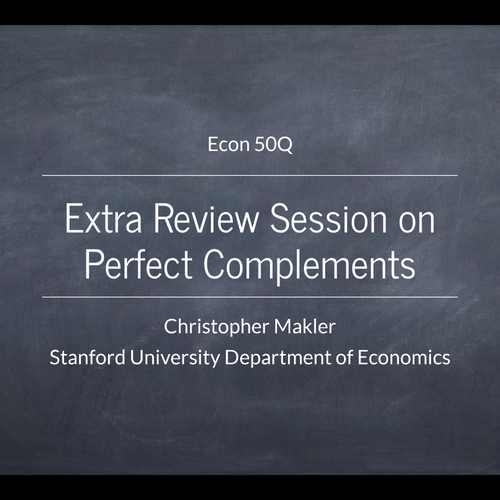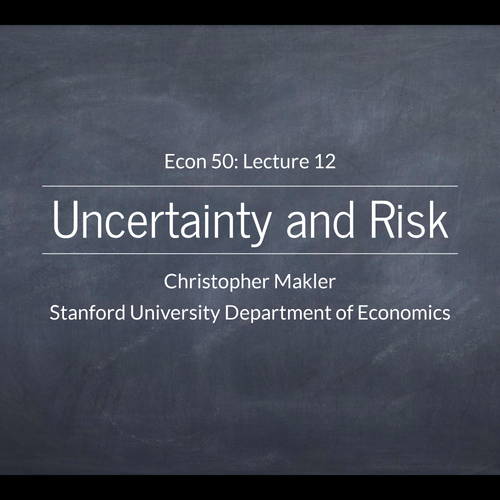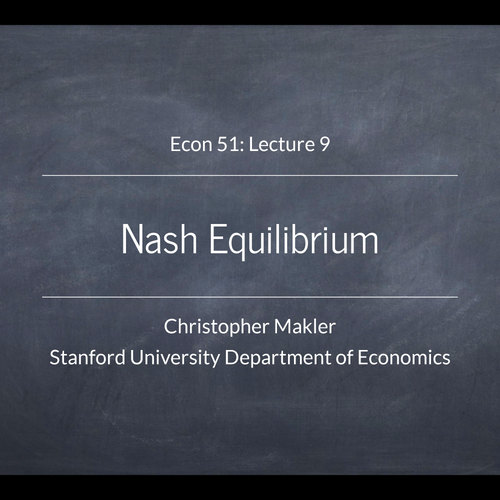-

Econ 50 | Fall 25 | Lecture 25
Course Retrospective
-

Econ 51 | 19 | Price Discrimination
Designing mechanisms to reveal preferences
-

Econ 51 | 18 | More Fun with the Principal-Agent Model
How to design a mechanism to get someone to behave a certain way, or to reveal their true preferences
-

Econ 50 | Fall 25 | Lecture 24
The Long Run
-

Econ 51 | 17 | The Principal-Agent Model
How to design a mechanism to get someone to behave a certain way, or to reveal their true preferences
-

Econ 50 | Fall 25 | Lecture 23
Public Goods and Common Resources
-

Mamdami, Trump, and Milton Friedman
Welfare Analysis of Equilibrium
-

Econ 50 | Fall 25 | Lecture 22
-

Econ 51 | 16 | Uncertainty and Risk
Uncertainty and Risk Aversion
-

Econ 50 | Fall 25 | Lecture 21
Bringing supply and demand together
-

Econ 50 | Fall 25 | Lecture 20
Welfare Analysis of Equilibrium
-

Econ 51 | 15 | Signaling and Lemons
Perfect Bayesian Equilibrium and Signaling Models
-

Econ 50 | Fall 25 | Lecture 19
Bringing supply and demand together
-

Econ 51 | 14 | Dynamic Games of Incomplete Information
Perfect Bayesian Equilibrium and Signaling Models
-

Econ 50 | Fall 25 | Lecture 18
Output Supply and Labor Demand for a Competitive Firm
-

Econ 51 | 13 | Static Games of Incomplete Information
Bayes Nash Equilibrium and Auctions
-

Econ 50 | Fall 25 | Lecture 17
Profit Maximization, With and Without Market Power
-

Econ 50 | Fall 25 | Lecture 16
Production and Cost for a Firm
-

Econ 50 | Fall 25 | Lecture 15
Production and Cost for a Firm
-

Econ 51 | 12 | Repeated Games
Sequential Games of Complete and Perfect Information
-

Econ 50 | Fall 25 | Lecture 14
Production and Cost
-

Econ 51 | 11 | Dynamic Games and Subgame Perfection
Sequential Games of Complete and Perfect Information
-

Econ 50Q | Review of Perfect Complements
Characteristics of Utility Functions
-

Econ 50 | Fall 25 | Lecture 13
We apply the framework of consumer choice theory to the choice of how to allocation money across time, investigating saving and borrowing.
-

Copy of Econ 51 | 10 | Oligopoly
Cournot duopoly and other applications of Nash equilibrium
-

Econ 50 | Fall 25 | Lecture 12
Uncertainty and Risk Aversion
-

Econ 51 | 09 | Nash Equilibrium
Nash equilibrium in pure and mixed strategies
-

Econ 50 | Fall 25 | Lecture 11
We apply the framework of consumer choice theory to the choice of how to allocation money across time, investigating saving and borrowing.
-

Econ 50 | Fall 25 | Lecture 10
-

Econ 51 | 08 | Dominance, Best Response, and Rationalizability
The first steps to understanding strategic behavior: what will you NOT do? What, based on your beliefs about the other players' strategies, might you do?
-

Econ 50 | Fall 25 | Lecture 09
Demand Functions and Demand Curves
-

Econ 51 | 07 | Introduction to Game Theory
Notation and definitions
-

Econ 50 | Fall 25 | Lecture 08
Constrained Optimization when Calculus Doesn't Work
-

Econ 50 | 06 | The Neoclassical Model
General equilibrium
-

Econ 51 | 05 | Comparative Advantage
Comparative Advantage and the Gains from Trade
-

Econ 50 | Fall 25 | Lecture 08
Constrained Optimization when Calculus Doesn't Work
-

Econ 50 | Fall 25 | Lecture 07
Corner solutions
-

Econ 50 | Fall 25 | Lecture 06
Constrained optimization when calculus (the Lagrange method) works
-

Econ 51 | 04 | Competitive Equilibrium
Efficiency and Equity in the Edgeworth Box
-

Econ 50 | Fall 25 | Section 2
The Mathematics of Optimization
-

Econ 50 | Fall 25 | Lecture 05
Budget constraints and the price ratio
-

Econ 51 | 03 | Trading from an Endowment
Building the Basis of Exchange Equilibrium
-

Econ 50 | Fall 25 | Lecture 04
Modeling Different Types of Preferences with Utility Functions
-

Econ 50 | Fall 25 | Lecture 03
Modeling Production with Multivariate Functions
-

Econ 51 | 02 | Efficiency and Equity in the Edgeworth Box
Efficiency and Equity in the Edgeworth Box
-

Econ 50 | Fall 25 | Lecture 02
Preferences, Indifference Curves, and Utility Functions
-

Econ 51 | 01 | Welcome and Review of Econ 50
Welcome and Review of Econ 50
-

Econ 50 | Fall 25 | Lecture 01
Welcome to Econ 50
-

Econ 50 | Spring 25 | Lecture 25
Course Retrospective
-

Econ 50 | Spring 25 | Lecture 24
Public Goods and Common Resources